
Concept explainers
(a)
Interpretation:
Whether
Concept introduction:
Sugars show different types of isomerism. They may be enantiomers, epimers, anomers, or diastereomers depending upon chirality and plane of symmetry in molecules. It also depends on stereochemistry of different carbons.
Answer to Problem 24.39AP
The compounds,
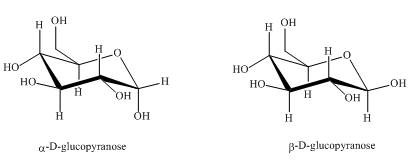
Explanation of Solution
The compounds,
They are diastereomers also as they are not mirror images of each other. The structure of both the compounds is shown below.

Figure 1
These two compounds are anomers as well as diastereomers as shown in Figure 1.
(b)
Interpretation:
Whether
Concept introduction:
Sugars show different types of isomerism between molecules. They may be enantiomers, epimers, anomers, or diastereomers depending upon chirality and plane of symmetry in molecules. It also depends on stereochemistry of different carbons.
Answer to Problem 24.39AP
The compounds,
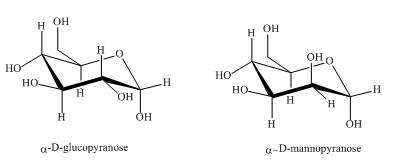
Explanation of Solution
Both the above structures of

Figure 2
The compounds
(c)
Interpretation:
Whether
Concept introduction:
Sugars show different types of isomerism between molecules. They may be enantiomers, epimers, anomers, or diastereomers depending upon chirality and plane of symmetry in molecules. It also depends on stereochemistry of different carbons.
Answer to Problem 24.39AP
The compounds,
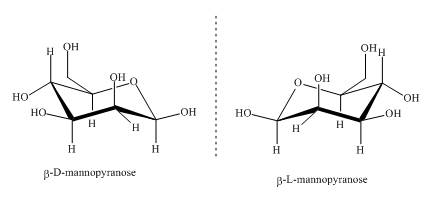
Explanation of Solution
Sugars can be divided into two groups based on the symmetry of carbon atoms. If the molecule has asymmetric carbon atom it will have a non superimposable mirror image. The non superimposable mirror images are known as enantiomers. As the given compounds are non super imposable mirror images of each other they are enantiomers. This can be well explained by the illustrations shown below.

Figure 3
These two compounds
(d)
Interpretation:
Whether
Concept introduction:
Sugars show different types of isomerism between molecules. They may be enantiomers, epimers, anomers, or diastereomers depending upon chirality and plane of symmetry in molecules. It also depends on stereochemistry of different carbons.
Answer to Problem 24.39AP
The compounds,
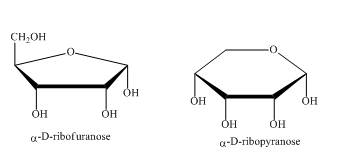
Explanation of Solution
As the isomers are the compounds, having similar chemical formula but different structures. These two compounds have same chemical formula. The chemical structure is of these two compounds is quite different as shown in Figure 4.

Figure 4
In the above shown compounds, one is a pentose sugar furanose while the other is a hexose sugar pyranose.
These two compounds,
(e)
Interpretation:
Whether
Concept introduction:
Sugars show different types of isomerism between molecules. They may be enantiomers, epimers, anomers, or diastereomers depending upon chirality and plane of symmetry in molecules. It also depends on stereochemistry of different carbons.
Answer to Problem 24.39AP
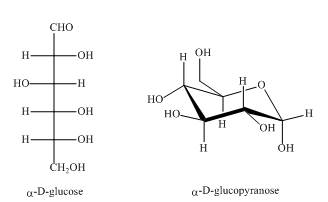
Explanation of Solution
As the isomers are the compounds, having similar chemical formula but different structures. Both the above structures are constitutional isomers as shown below in the Figure.

Figure 5
In the above shown compounds, one is a ring structure having keto group while the other is open ring structure having aldehyde as the
The given compounds
(f)
Interpretation:
Whether the compounds,
Concept introduction:
Sugars show different types of isomerism between molecules. They may be enantiomers, epimers, anomers, or diastereomers depending upon chirality and plane of symmetry in molecules. It also depends on stereochemistry of different carbons. The naming of the same compound can be done in different manners.
Answer to Problem 24.39AP
The compounds,
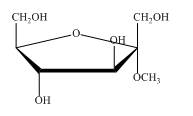
Explanation of Solution
The structure of

Figure 6
So, the compound is same, they are identical. In first name it is taken as methyl derivative of
The compound shown in Figure 6 can be named as
Want to see more full solutions like this?
Chapter 24 Solutions
ORGANIC CHEM +SG +SAPLING >IP<
- Can I get helpp drawing my arrowsarrow_forwardWhich of the m/z values corresponds to the base peak in the mass spectrum shown? 100 80 A. 45 B. 44 C. 29 D. 15 Intensity 20 0 10 20 30 40 B- m/z -8 50 E. 30 Which of the m/z values correspond to the molecular ion for the compound shown? A. 18 B. 82 OH C. 100 D. 102 E. 103arrow_forwardCan someone help me with drawing my arrows.arrow_forward
- I'm having trouble with converting lewis diagrams into VSEPR diagrams. I currently have this example of C2BrCl3 which I want to turn into a lewis structure, but I'm not sure what steps I need to do in order to do so. I have the table written down, however, there's two central atoms so what would I do? There seems to be 4 electron domains on the carbon atom and no lone pairs so it would seem like this shape would be tetrahedral. Here's what I have now. Thanks!arrow_forwardWe discussed the solid phase resin using in peptide synthesis. Provide a mechanism, for its formation. DRAW THE MECHANISM.arrow_forwardPlease help. Every time I've asked an expert in the past, it's been wrong :(arrow_forward

 Organic ChemistryChemistryISBN:9781305580350Author:William H. Brown, Brent L. Iverson, Eric Anslyn, Christopher S. FootePublisher:Cengage Learning
Organic ChemistryChemistryISBN:9781305580350Author:William H. Brown, Brent L. Iverson, Eric Anslyn, Christopher S. FootePublisher:Cengage Learning Introduction to General, Organic and BiochemistryChemistryISBN:9781285869759Author:Frederick A. Bettelheim, William H. Brown, Mary K. Campbell, Shawn O. Farrell, Omar TorresPublisher:Cengage Learning
Introduction to General, Organic and BiochemistryChemistryISBN:9781285869759Author:Frederick A. Bettelheim, William H. Brown, Mary K. Campbell, Shawn O. Farrell, Omar TorresPublisher:Cengage Learning


